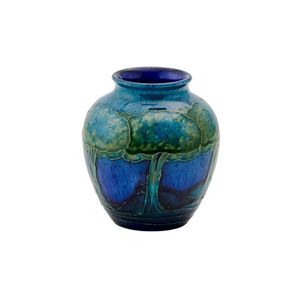Emerald Green Lalique Thistle Vase, 1926 Design
You must be a subscriber, and be logged in to view price and dealer details.
Subscribe Now to view actual auction price for this item
When you subscribe, you have the option of setting the currency in which to display prices to $Au, $US, $NZ or Stg.
- Emeralds - Emeralds have been used in jewellery making for thousands of years, and are prized for their deep green colour, which is caused by the presence of chromium and vanadium in the mineral beryl. Because of their rare colour, emeralds are often more valuable than diamonds of a similar size and quality. In jewellery making, emeralds are typically cut into round or oval shapes to maximize their color and clarity. They are often set in gold or platinum and used as the centrepiece of a piece of jewellery, such as a ring or necklace. They can also be used in combination with other gems, such as diamonds, to create intricate and beautiful designs.
- Baluster (glass) - An architectural term for a column in a balustrade or staircase.
When used to describe glass, it can either refer to the shape of the stem of a wine glass, being slender above and pear shaped below, or the shape of the whole vessel, usually a vase. In fact the baluster shape is often described as being vase-like.
The description of a vase as being of baluster shape covers a wide variety of shapes that often bear no resemblance to the original architectural form.
This item has been included into following indexes:
-
Lalique (France), item types
- other items 1,071
- vases 546
- Lalique (France), patterns, vases - Domremy 11
- Schneider / Le Verre Francais (France) - lamps and lighting 303
Visually similar items

A Chinese Longquan vase, Ming dynasty, 17th century, moulded and incised with a continues peony scroll. 21.8 cm high

An inscribed landscape vase, 20th century of upright form, the sides painted with figures in a continuous mountain landscape between formal blue enamel borders around the splayed foot, shoulders and galleried mouth, an inscription in black with a red seal,

A fine quality Chinese basse-taille cloisonne vase, ovoid with short neck, pink and white roses on a rich red ground with bird and bamboo. Height 18.5 cm

A Moorcroft 'Moonlit Blue' vase, circa 1925, the ovoid body painted and tube lined in the round with a scene depicting a landscape at dusk, on a deep blue ground, stamped 'Moorcroft' and 'Made in England' with an underglaze blue painted signature, 10.5 cm
